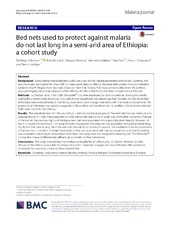| dc.contributor.author | Solomon, Tarekegn | en_US |
| dc.contributor.author | Loha, Eskindir | en_US |
| dc.contributor.author | Deressa, Wakgari | en_US |
| dc.contributor.author | Balkew, Meshesha | en_US |
| dc.contributor.author | Gari, Taye | en_US |
| dc.contributor.author | Overgaard, Hans Jørgen | en_US |
| dc.contributor.author | Lindtjorn, Bernt | en_US |
| dc.date.accessioned | 2019-05-27T13:33:48Z | |
| dc.date.available | 2019-05-27T13:33:48Z | |
| dc.date.issued | 2018-06-20 | |
| dc.Published | Solomon, Loha E, Deressa W, Balkew M, Gari T, Overgaard HJ, Lindtjorn B. Bed nets used to protect against malaria do not last long in a semi-arid area of Ethiopia: A cohort study. Malaria Journal. 2018;17:239 | eng |
| dc.identifier.issn | 1475-2875 | |
| dc.identifier.uri | https://hdl.handle.net/1956/19734 | |
| dc.description.abstract | Background: Long-lasting insecticidal nets (LLINs) are a key tool for malaria prevention and control. Currently, the recommended serviceable life of an LLIN is 3 years under field conditions. However, field studies show considerable variation in LLIN lifespan, from less than 2 years to more than 4 years. This study aimed to determine the attrition, physical integrity, functional survival, and bio-efficacy of LLINs under field conditions in south-central Ethiopia. Methods: In October 2014, 7740 LLINs (PermaNet® 2.0) were distributed to 3006 households. Among the distributed LLINs, a cohort study involving 1532 LLINs in 659 households was carried out from October 2014 to November 2016. Data were collected every 6 months by observation, and through interviews with the heads of households. The proportional hole index was used to categorize LLINs as either serviceable or torn. In addition, 120 randomly selected LLINs were tested for bio-efficacy. Results: The overall attrition of LLINs was 96% (n = 993) during the study period. The nets’ attrition was mainly due to disposal (64.2%; n = 638). The proportion of LLINs with a hole size 0.5 cm or larger was 79.5% after 24 months. The use of the net on the previous night and having a clean net were associated with a good physical integrity. However, living in a household more than 1 km away from the mosquitoes’ breeding site was associated with poor physical integrity. By the 24th month, only 4% of the nets met the criteria for functional survival. The median functional survival time of the nets was 12 months. A longer functional survival was associated with having a clean net, and shorter survival was associated with living in a household more than 1 km away from the mosquitoes’ breeding site. The PermaNet® 2.0 met the criteria of effective bio-efficacy up to month 24 after distribution. Conclusions: The study showed that the median serviceable life of LLINs is only 12 months. However, the bio-efficacy of the LLINs is acceptable for at least 24 months. Therefore, stronger and more efficient LLINs need to be developed for conditions similar to those studied here. | en_US |
| dc.language.iso | eng | eng |
| dc.publisher | BioMed Central | eng |
| dc.rights | Attribution CC BY | eng |
| dc.rights.uri | http://creativecommons.org/licenses/by/4.0 | eng |
| dc.subject | Durability | eng |
| dc.subject | Long-lasting insecticide nets | eng |
| dc.subject | Attrition | eng |
| dc.subject | Physical integrity | eng |
| dc.subject | Functional survivorship | eng |
| dc.subject | Ethiopia | eng |
| dc.title | Bed nets used to protect against malaria do not last long in a semi-arid area of Ethiopia: A cohort study | en_US |
| dc.type | Peer reviewed | |
| dc.type | Journal article | |
| dc.date.updated | 2019-01-07T13:26:52Z | |
| dc.description.version | publishedVersion | en_US |
| dc.rights.holder | Copyright 2018 The Author(s) | |
| dc.identifier.doi | https://doi.org/10.1186/s12936-018-2391-5 | |
| dc.identifier.cristin | 1596556 | |
| dc.source.journal | Malaria Journal | |

